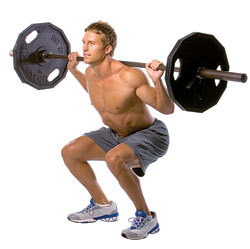Most people don’t squat correctly. They bend at the spine, rely too much on their thigh muscles, minimize the use of their butt muscles, lift their heels and collapse their chests. Poor leg, hip and spinal mechanics put excessive stress on the knees and back and will eventually lead to injury. Stand with your feet placed slightly more than shoulder-width apart, toes pointed out slightly, head neutral, back straight and support the bar on the fleshy part of your upper back.
Center your weight over your arches or slightly behind. Squat down, keeping your weight centered over your arches and actively flex your hips until your thighs break parallel. During the movement, keep your back straight, shoulders back, chest out, head neutral and let your thighs part to the side so that you are squatting between your legs. During the movement, try to spread the floor with the outside of your feet as you drop to the squat position. Push back to the starting position, maximizing the use of the posterior hip and thigh muscles, maintaining a straight back and neutral head position. Paul Comfort and Peter Kasim from the London Sports Institute concluded that the essential elements of the squat for minimizing injury and maximizing strength include a wide stance with natural foot positioning, keeping the weight back by hinging at the hips and not the back, holding the head in a neutral position and maintaining the normal curves of the spine during the exercise.

